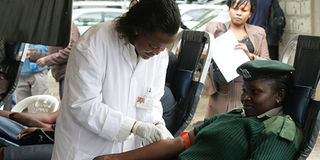Breaking News: At least 10 feared to have drowned in Makueni river
Report warns hospitals not equipped for fire disasters

Jennifer Muiruri | NATION
A medical worker at the Kenyatta National Hospital collects blood from a prison warder to help victims of the Sinai Slum fire tragedy on September 13, 2011. Authorities say 97 survivors are in hospital with burn injuries.
What you need to know:
- Experts say situation in local hospitals likely to hamper efforts to save survivors of slum blaze
Attention, anguish and pain of the Sinai fire tragedy turns to the Kenyatta National Hospital which is treating about 100 survivors.
While those with minor injuries treated and discharged from the hospital, for many others it could be months before they are healed.
Unfortunately, like the Sachang’wan fuel tragedy in 2009, hospital deaths could be very high.
According to the first comprehensive report of the Sachang’wan tragedy, of the 89 victims admitted at the Nakuru Provincial General Hospital, half of them died in the first week of hospitalisation.
Lessons from the Sachang’wan tragedy indicate that the current patients may require huge blood transfusions and long hospital stay going up to four months.
“Twenty patients of the Sachang’wan accident were transfused 73 units of blood including one who received nine units,” according to the report published in the September issue of Journal Trauma.
The report by a team of researchers concludes that hospital deaths following the disaster were high because of inadequate medical facilities.
Health professionals classify burns as first, second or third degree.
First degree or superficial burns affect only the top layer of the skin and are painful to the touch. They sometimes cause small blisters, but usually heal rapidly on their own.
Second degree burns affect both the first and second layers of the kin (dermis and the epidermis) and often cause pain, fever, swelling, chills and blisters.
At this level a victim may start to lose fluid, heat, and the ability to block infection and will require to medical attention.
A burn will be classified as third degree when it has affected deeper layers of body tissue, including nerves, sweat glands, fat, and hair follicles.
Patients with burns involving less than 20 per cent of their body surface are expected to recover on getting proper medical care, but those with burns involving of over 50 per cent have a higher risk of death.
Kenya lacks a facility that can handle mass burn disaster victims.
According to Kenyatta National Hospital CEO, even with 60 emergency patients, the facility is already in crisis. It has a 22-bed burns unit.




